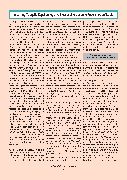Imparting Mosquito Repellent Agents & Assessing Mosquito Repellency on Textile Clothing can be treated with anti-agents to keep mosquitoes from arriving or encouraging, on the other hand, with fast acting aerosol spray of the pyre- throid gathering, for example, per- methrin. These recent mixes does not repulse the mosquitoes yet permit them to reach with the fabric and ag- gravate or killing them before they fig- ure out how to bolster. The application of anti-agents to dress and different fabrics is desirable over skin applica- tion on the grounds that it diminishes the probability of hypersensitive re- sponses. Former USSR have been developed a vest that claimed as anti- mosquito gar- ment which consist of long sleeves made from wide mesh materials with 0.5 cm fibres thick (Ro- zendaal 1997). Study by Shannon iden- tifies that garment piece with defensive pieces of clothing adjusted to be worn by outdoorsmen give protection against mos- quitoes and different arthropods without any repellent treatment on the fabric. The garment comprises the multilayer of fabric consist of outer and inner layers which are connected at the seams (Shannon 1988). The upholster- ies and outdoor textile items as listed on the Table 1 are existing products that have been developed to be used as individual outdoorsmen, housewife and also family. Most of protective mosquito tex- tiles were treated using DEET or Permethrin by spraying the repellents from a pressurized can or by dipping it in the aqueous emulsion. For the netting jackets head nets, the materials are made from a blend of polyester/cotton, which being treated with DEET for easy absorption of the mosquito agent. The disadvantage of the netting jacket is that the structure of the jacket which is made of a wide mesh can be easily entangled. Anoth- er limitation is the netting materials must be wrapped in a plastic bag when not in use. Another example of mosquito repellent associated with fabric is the detach- able patches with Velcro strips, press buttons or adhesive sticker. The treat- ed patches can be easily removed anddo not have a direct contact with the skin, therefore provides safety protec- tion against mosquito Hammocks are made from textile materials for resting and sleep- ing, especially in jungle ar- eas by outdoormens. It will be hung onto the tree or anything that is tall enough to keep off the ground from soil, crawling insect, snake, scorpions and anything small insects. However, hammock does not protect users from the flying insect such as mosquitoes. Mosquitoes often attack hammock user from the lower part of the ham- mock where the body presses the tex- tile. There are a few suggestions to make hammock more protective against mosquito. Application of repel- lent such as spraying to the lower part of the hammock may avoid the mos- quito to get near. A more economical method which requires a less repellent agent is by attaching the netting ma- terials such as a piece of cloth which has been treated with repellent agent at the lower part of the hammock. This method can provide partial protection from biting mosquitoes. Another way for long lasting protection is to impreg- nate the whole hammock with the re- pellent. Another protective mosquito textiles are mosquito nets. The traditional net- ting materi- als are made from raffia (palm fibre), linen or hemp compared to the modern net which made from cotton and man-made fibre such as nylon, polyester or polyethylene. The mesh size of mosquito nets is between 1.2 and 1.5 mm, (if more that 2 mm most mosqui- toes can enter). The structure of the netting materials can be woven or knitted. In terms of co- lour, white color is more preferred as mosquitoes that entered the nett can be easily noticed compared to a dark- er colour netting. For more protection, the mosquito net can be treated with mosquito repellent agent during the production as it can act as physical barrier to the entry of the mosquitoes (Rozendaal 1997). Insecticide-treated bed nets are likely among the most well studied exam- NCM-OCTOBER 2021 38ples and good indication of their viabil- ity against bites and their significant effect on pathogen trans- mission has been accounted for by WHO (Banks et al. 2014). The concerns regarding treated clothes with repellents such as DEET, are they really not irritate hu- man skin of applied at to the cloth or direct contact to skin. Are they pleas- ant to use in daily wear such as odour problem, greasiness or colour chang- es on the textile. Methods of imparting repellent on textile materials Based on the review of literatures, there were various techniques to im- part the mosquito repellent agents into the fabrics. Table 3 below shows the various studies of imparting tech- niques onto the textile materials. According to Banks et al. (2014) there are four main techniques to achieve the method of repellent textile which are absorbed, incorporation, polymer coating and microencap- sulation. The absorption technique comprises the method of spraying, dipping or pad dry cure to fabrics, along with the use of repellent agent. While the corporation technique mainly used in carpets in- dustry involves the process of pretreat- ment carpet during the manufacturing or dyeing process (McCamy and Clark 1996). The polymer coating and mi- croencapsulation having similar tech- nique which exhibit a layer of polymers coated onto the textiles fibre, but the microencapsulation must be in capsule form that mixed to binding solution (Appel et al. 2008; Banks et al. 2014; Faulde and Uedelhoven 2006). Five studies (Anitha et al. 2011; Fei and Xin 2007; Paya et al. 2010; Vigneshkumar and Vijaykumar Vediappan 2012) re- ported the treated textile with mosqui- to repellents use the method of pad dry cure method of the microencapsu- lation repellents either from natural or chemical sources. The existing devel- opments using synthetic repellent in- cluding insect textile repellent as men- tion above. This is done by impregnat-
